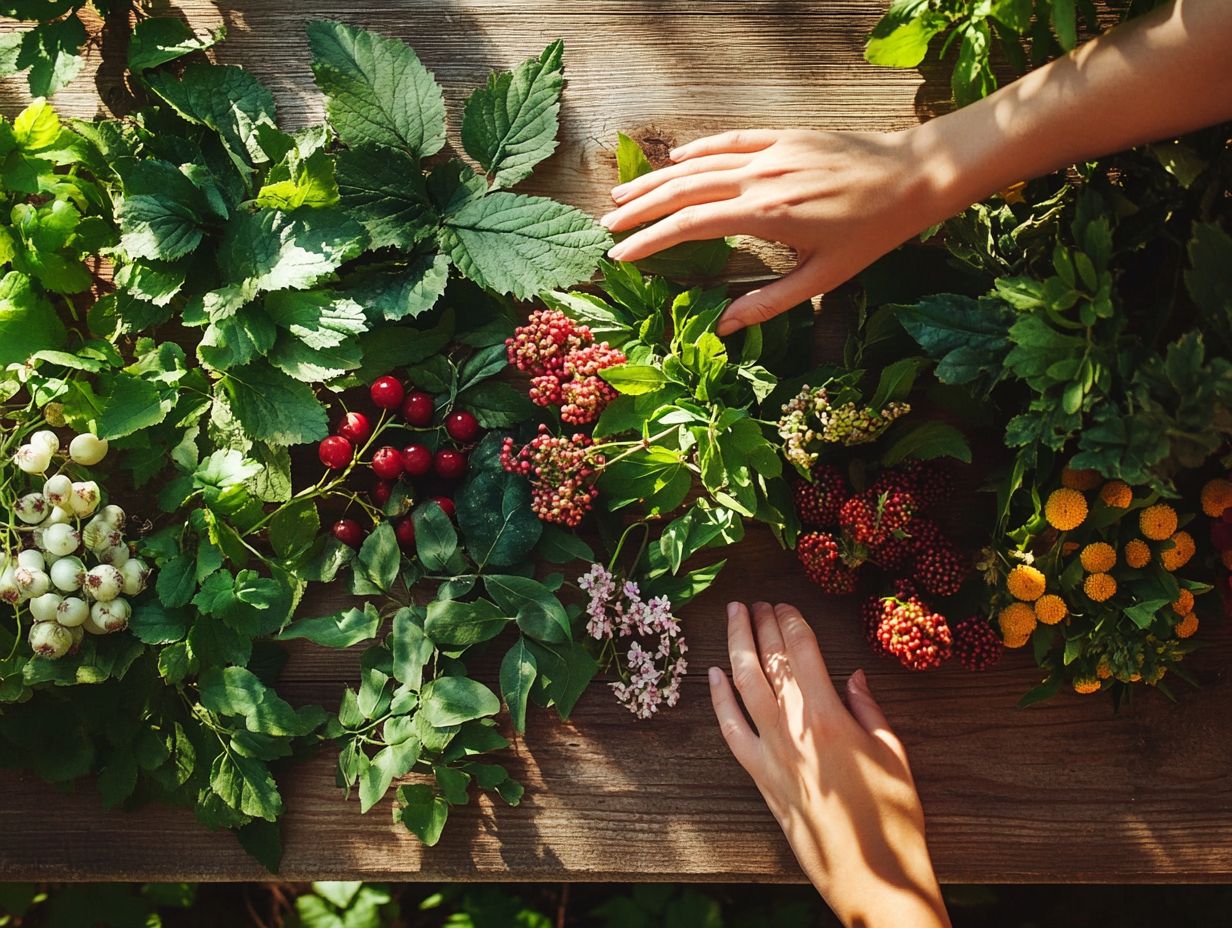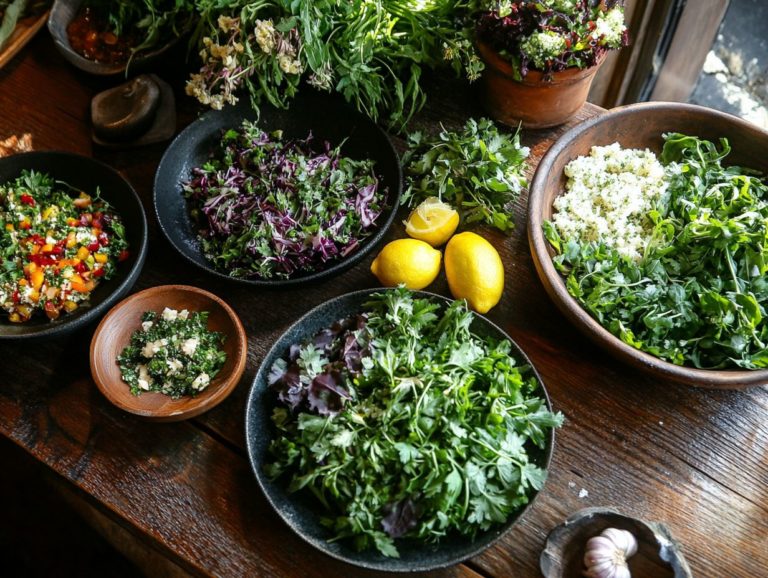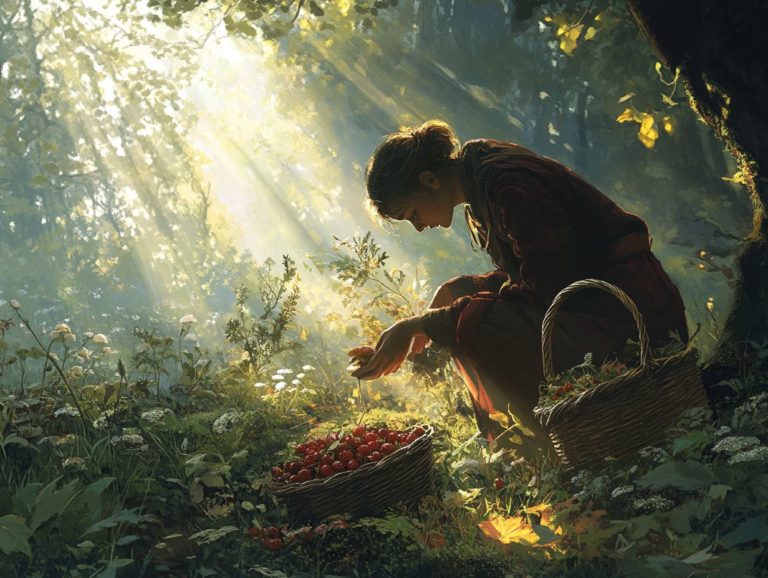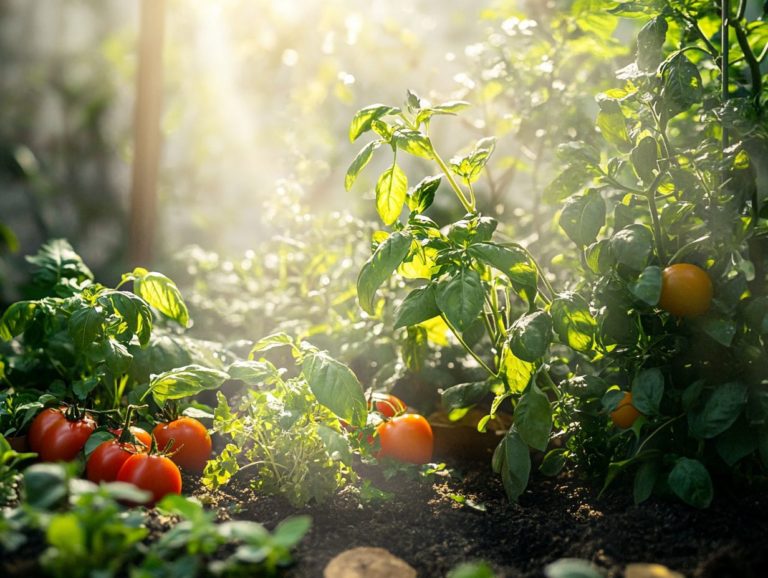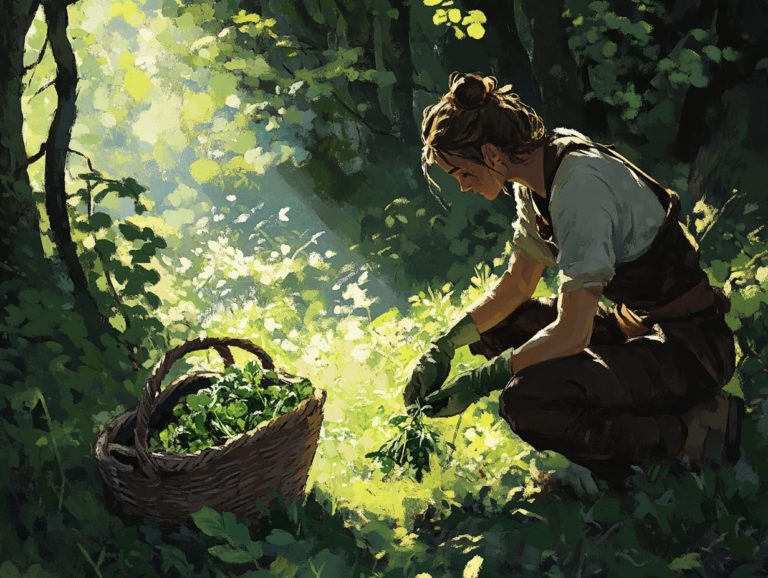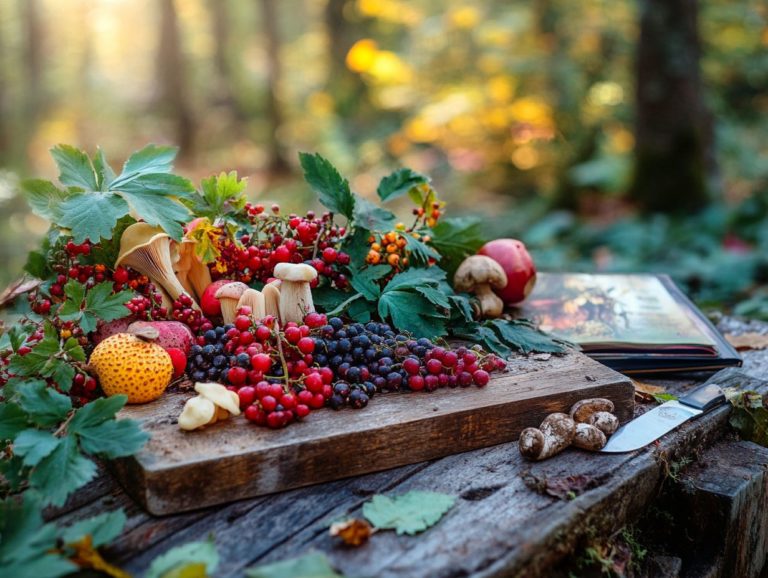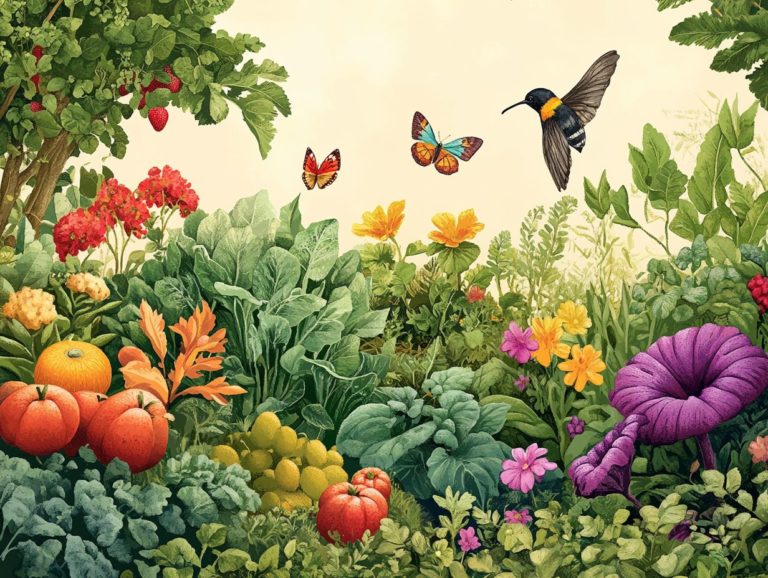Wild Edible Plants: A Beginner’s Guide
Wild edible plants provide a delightful and nutritious opportunity to elevate your diet while deepening your connection with nature. Explore the myriad benefits of incorporating these natural treasures into your meals, from their remarkable nutritional profiles to their potential health benefits.
Equip yourself with essential tips for identifying and sustainably harvesting these plants, alongside safe preparation methods that will enhance your culinary experience. Whether you re a curious novice or a seasoned forager, this guide empowers you to navigate the world of wild edibles with confidence and flair.
Contents
Key Takeaways:
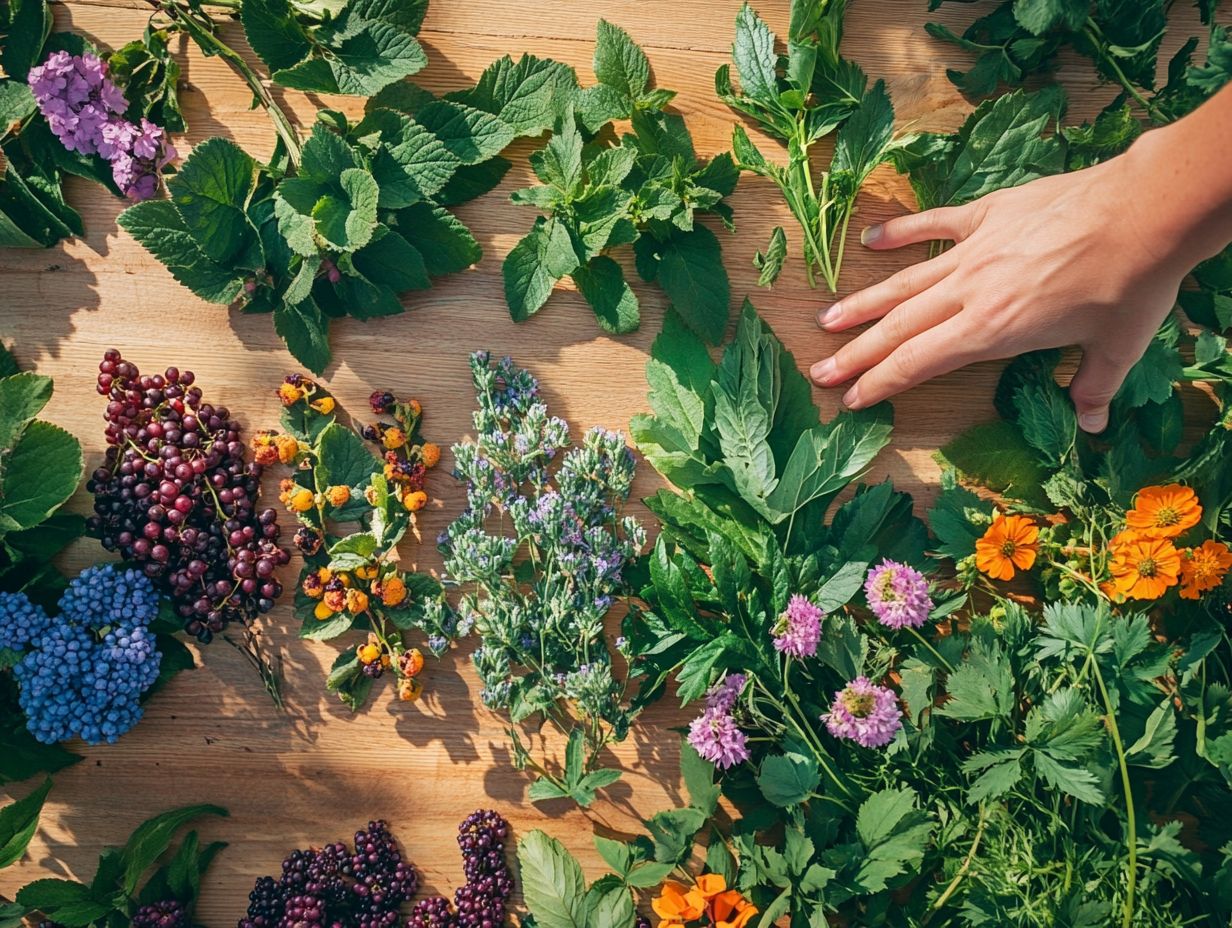
- Eating wild edible plants can provide numerous health benefits due to their high nutritional value.
- Proper identification and sustainable harvesting practices are crucial for safely incorporating wild edible plants into your diet.
- Some common and beginner-friendly wild edible plants include dandelions, blackberries, and elderberries.
What are Wild Edible Plants?
Wild edible plants are a fascinating and diverse collection of plants that you can safely harvest and savor, offering a wealth of nutrition and culinary variety. Found in a multitude of habitats, these plants provide not just sustenance but also an exhilarating avenue for exploration and self-sufficiency through gathering wild foods from nature.
With the rising interest in sustainable living and locally sourced food, understanding wild edibles has become increasingly relevant in today’s food-conscious culture. From identifying familiar plants like elderberries and prickly pear cactus to navigating local ecosystems, you can dive into nature’s bounty today while deepening your botanical knowledge.
Incorporating wild edibles into your daily diet is not just beneficial for your health; it also nurtures a profound connection to the environment. These plants are packed with vitamins, minerals, and antioxidants, beautifully complementing traditional foods and enriching your meals with unique flavors and nutritional perks.
For example, dandelion greens can help relieve digestive woes, while wild garlic can elevate your culinary creations with its robust taste. Beyond their nutritional value, foraging for wild edibles holds cultural significance, linking generations through shared knowledge and practices. Honing your skills in plant identification becomes essential if you re eager to embark on this rewarding journey into nature s pantry.
Benefits of Incorporating Wild Edible Plants into Your Diet
Incorporating wild edible plants into your diet offers a wealth of benefits, enhancing your nutrition while deepening your connection with nature. These nutrient-dense snacks often outshine conventional produce in vitamins and minerals, making them a superb choice for anyone mindful of their health.
Foraging for wild edibles encourages community engagement; local foraging groups frequently share invaluable tips and knowledge on how to identify and safely consume these plants. This hands-on learning experience not only boosts your personal well-being but also champions a sustainable lifestyle by promoting the practice of sourcing food directly from nature’s abundant offerings, enhancing your botanical knowledge.
Nutritional Value and Health Benefits
Wild edible plants are a treasure trove of essential nutrients, making them an invaluable addition to a balanced diet. Rich in antioxidants, vitamins, and minerals, these plants can significantly enhance your overall health. The practice of foraging cultivates a deeper appreciation for nature and its offerings.
By understanding the nutritional value of these edible gems, you not only elevate your culinary experience but also arm yourself with knowledge that can prove invaluable during emergency foraging situations, where safe consumption is crucial. Take morels, for example. They stand out as a prime source of vitamin D, which supports bone health and boosts immunity.
Wild mushrooms, in general, are lauded for their low-calorie content and high selenium levels an essential mineral that plays a pivotal role in antioxidant defense. Incorporating these nutrient-dense wild edibles into your meals can enrich not only your nutrition but also your cooking skills. However, it’s essential to master proper identification and preparation methods to ensure safety, as some wild edibles can be toxic if mishandled.
Identifying and Harvesting Wild Edible Plants
Identifying and harvesting wild edible plants requires a fusion of plant knowledge, sharp observation, and hands-on experience. Foraging is not just a skill; it’s an art that demands an understanding of the distinctive features of various plants, including their seasonal traits, to practice safely and sustainably.
Relying on reputable resources, such as field guides and plant identification apps like iNaturalist or Plantnet, can significantly enhance your ability to recognize common edibles. Joining foraging workshops led by seasoned experts think John Kallas or Christopher Nyerges will equip you with invaluable knowledge on safe harvesting techniques and help you avoid toxic look-alikes, which are plants that look similar but are harmful.
Tools and Techniques for Identification
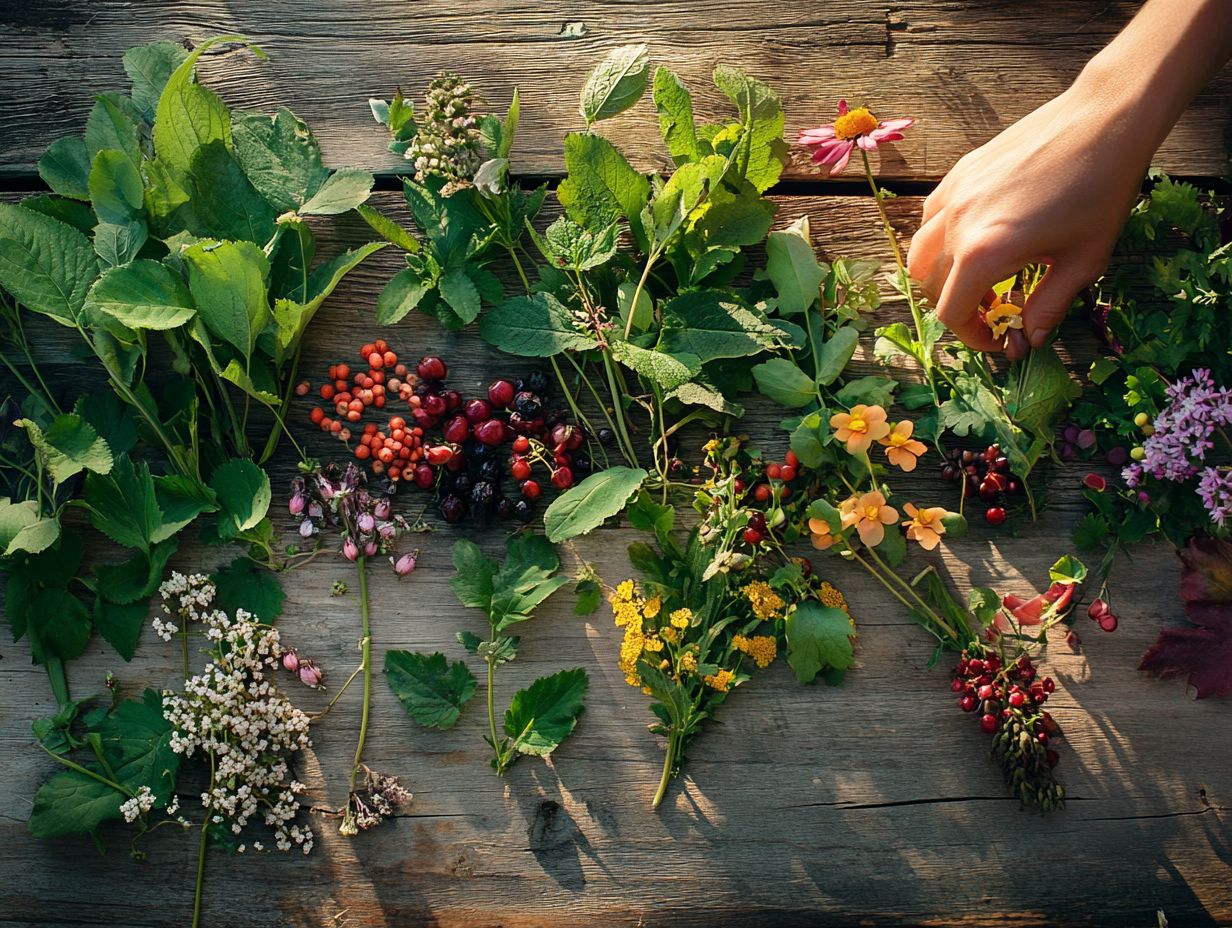
Identifying wild edible plants can be thrilling, blending traditional methods with modern technology, like plant ID apps. Resources such as Peterson’s Field Guide and community crowdsourcing platforms offer valuable insights into the distinctive features of various edible plants, while also emphasizing the importance of sustainable harvesting for future generations.
By grasping plant knowledge and understanding characteristics like leaf shape, flower color, and habitat, you can significantly enhance your foraging success. Apps like iNaturalist help you document your plant observations and connect with other foragers, enriching your learning journey.
In addition to these tools, participating in guided nature walks and local workshops provides hands-on learning opportunities. This enables you to engage directly with the rich flora in your surroundings.
Engaging with community groups facilitates knowledge exchange and fosters a shared appreciation for nature’s bounty. Participating in local foraging adventures allows you to share your experiences and photos, deepening your understanding while inspiring others to develop a passion for wild edibles.
This collaborative approach to plant identification elevates your skills and strengthens community bonds. Ultimately, it promotes a sustainable lifestyle rooted in botanical literacy.
Sustainable Harvesting Practices
Sustainable harvesting practices are vital for striking a balance between your consumption and the health of plant ecosystems. When foraging, act responsibly to protect our ecosystems today! It’s essential to follow safety guidelines that minimize your environmental impact. This means taking only small portions from each plant to allow populations to regenerate and flourish.
Familiarizing yourself with foraging safety measures, such as identifying poisonous plants and their toxic look-alikes, can keep you safe while supporting responsible consumption of nature’s bounty.
Being mindful during your harvest not only benefits the ecosystem but also enriches future foraging experiences for others. Approach each outing with a sense of reverence and restraint, especially when you come across easily misidentified plants like poison ivy and belladonna, which can pose serious risks if ingested. Always leave enough foliage behind to ensure pollinators and wildlife have the resources they need.
By adopting these sustainable practices, you contribute to maintaining biodiversity, which means the variety of life in a particular habitat and is crucial for a healthy ecosystem. You will also foster a deeper connection with the natural world, paving the way for generations to safely enjoy its wonders while understanding the importance of food sourcing.
Preparing and Cooking Wild Edible Plants
Preparing and cooking wild edible plants demands an understanding of their unique characteristics, including specific cleaning and cooking methods that preserve their nutritional value and flavor. You ll find that different plants require varying treatments. For instance, some edible leaves can be enjoyed raw, while others need cooking to enhance their digestibility and taste.
Mastering the art of safe preparation whether it s gathering nuts or identifying berries can truly transform your foraged finds into delectable meals that honor nature’s bounty.
Cleaning and Cooking Methods
Cleaning and cooking methods for wild edible plants are essential for ensuring safe consumption and enjoying their unique flavors.
To enhance your foraging experience, it’s vital to accurately identify each plant before you indulge. Once you ve gathered your treasures, rinse them in cool water, using a soft brush to gently scrub away any stubborn soil or lingering insects. Pay attention to identifying features like leaf shape and color.
For greens like stinging nettles or dandelion, consider blanching them to reduce bitterness and improve safety. Steaming is another great option, as it preserves nutrients beautifully. Alternatively, saut ing with a splash of olive oil and garlic can elevate the flavors while effectively neutralizing any toxins through heat.
These careful preparation methods keep you safe and elevate your adventure! They also transform your experience into a delightful culinary adventure, allowing you to fully appreciate the diverse taste sensations and nutrient-packed snacks that nature has to offer.
Safety Considerations
Safety considerations are absolutely paramount when you embark on the adventure of foraging for wild edibles. The potential risks of encountering poisonous plants and their toxic look-alikes can pose serious threats to your health.
Know the essential foraging safety guidelines and implement cautionary measures to savor your foraging experiences without unwelcome consequences. It s crucial to familiarize yourself with the identifying features of both edible and poisonous plants, such as the notorious Death Cap mushroom and oleander.
This knowledge enables you to forage safely and confidently while minimizing risks.
Poisonous Lookalikes and Other Hazards
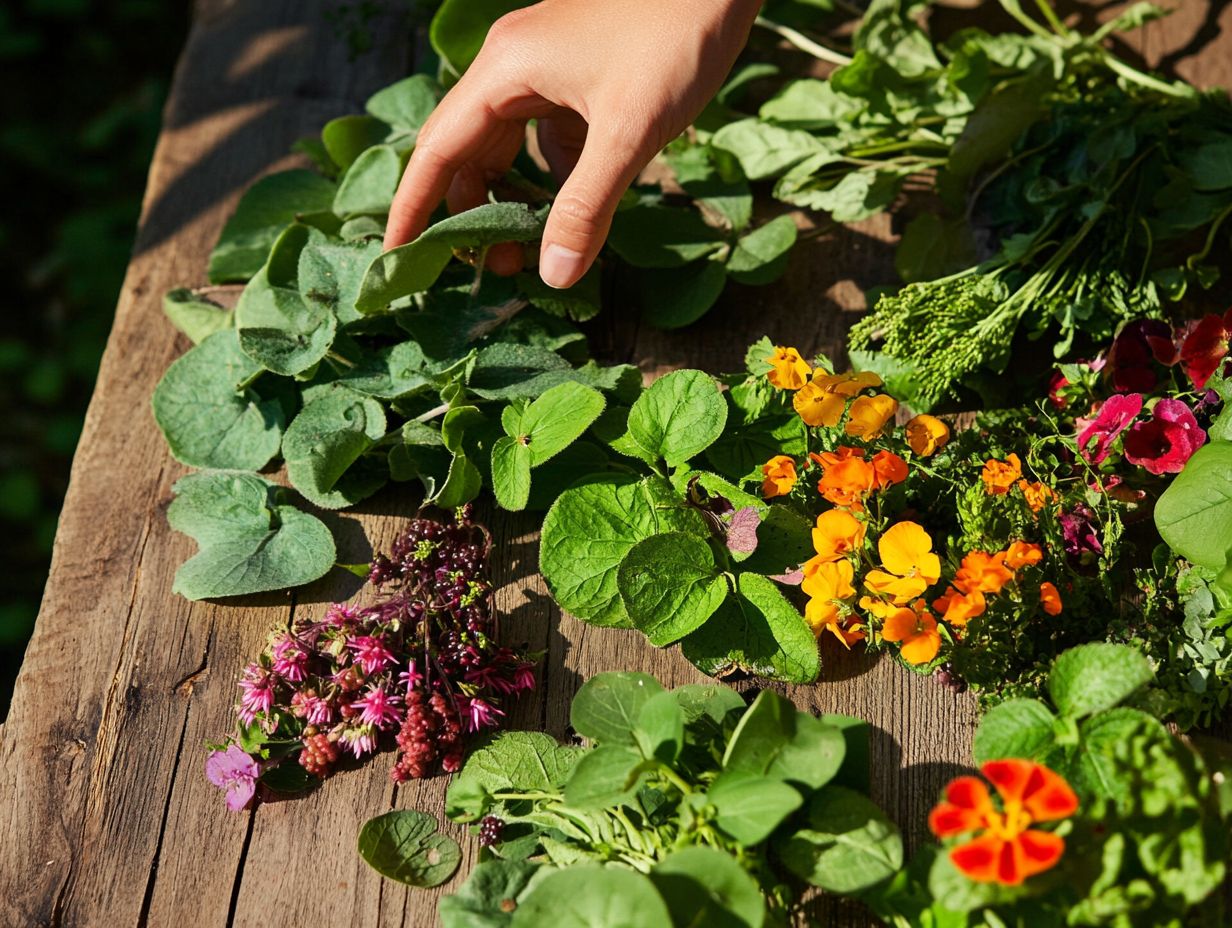
Recognizing toxic look-alikes is an essential skill for anyone seeking to forage for wild edibles. Many edible plants have poisonous counterparts that pose significant health risks. Take elderberries, for instance; they’re perfectly safe when cooked but can be harmful when consumed raw. Then there’s the infamous Death Cap mushroom, which is often mistaken for harmless varieties.
Understanding the precautions necessary when encountering these hazards enhances your foraging safety. It also enables you to make informed choices as you explore the wild.
The ability to identify these potentially dangerous imitations safeguards not just your well-being but also fosters a community of responsible foragers. Spotting toxic look-alikes greatly lowers your risk!
It’s wise to always double-check field guides and consult seasoned foragers before consuming unfamiliar plants. Developing the habit of documenting your findings with photographs can assist in recognizing specific traits, making it easier to distinguish between safe and harmful options.
By honing this skill, you can fully enjoy nature’s bounty while minimizing risks, especially by utilizing reliable resources and plant identification methods.
Getting Started: Easy-to-Find Wild Edible Plants
Get ready for an exciting adventure in nature! Embarking on the journey of wild foraging can be a truly enriching experience, especially when you focus on easy-to-find edible plants. To ensure your safety while foraging, it’s crucial to follow certain guidelines, such as the wild edibles safety tips that you should know, which help you enjoy your local ecosystems responsibly.
As a beginner, you can relish successful foraging outings by seeking out well-known plants like cattails and amaranth, both of which are nutritious and incredibly versatile. For more inspiration, explore wild edible plants: a culinary adventure, which highlights great examples of common plants.
Finding wild fruits and edible flowers can ignite a lasting passion for nature and its bounty, making foraging a fun way to learn about nature, particularly by learning about seasonal characteristics of these edible foods.
Don’t miss out on the fun start your foraging journey today!
Common and Beginner-Friendly Options
Begin your journey into the world of wild edibles with a selection of common, beginner-friendly plants that are both easily identifiable and simple to harvest. Consider options like wild strawberries, dandelion leaves, and even edible flowers such as violets. For a more comprehensive exploration, check out wild edibles in your backyard, which offer safe and nutritious choices for newcomers.
Gathering nuts like acorns and foraging for wild fruits like blackberries introduces a delightful array of flavors. This activity immerses you in the thrilling realm of edible plants available right in your local environment, showcasing the importance of finding food.
These foraging adventures connect you with nature while uncovering the diverse palette of tastes it offers. Picture yourself enjoying the delightful sweetness of wild raspberries or the peppery bite of mustard greens. Don t overlook the health benefits of herbs like plantain or purslane.
Each wild edible showcases unique characteristics shaped by its habitat whether nestled near streams, gracing open fields, or thriving in forested areas. This provides you with an invaluable opportunity to elevate your culinary experiences.
Embracing local options fosters a spirit of exploration, encouraging you to immerse yourself in the flavors of your surroundings. Relish the thrill of gathering food from the wild, making local foraging practices essential. Start your foraging adventure today and uncover the flavors waiting for you!
Frequently Asked Questions
What are wild edible plants?
Wild edible plants refer to any plant found in nature that can be safely consumed by humans. These plants can include fruits, vegetables, herbs, and even some flowers.
Why should I learn about wild edible plants?
Learning about wild edible plants can be beneficial for survival situations and for incorporating more diverse, nutrient-rich foods into your diet. Exploring resources on wild edibles: what to forage in winter can also help minimize the risks of food allergies.
What are some common types of wild edible plants?
Some common types of wild edible plants include dandelions, cattails, wild berries, wild garlic, and wild mushrooms. Understanding these is essential for identifying roots as well.
How can I identify wild edible plants?
It is important to properly identify wild edible plants before consuming them. You can do this through research, joining a foraging group, or taking a class on wild plant identification.
Are all wild plants safe to eat?
No, not all wild plants are safe to eat. It is important to properly identify and research any plant before consuming it, as some can be poisonous.
What are some safety precautions to take when foraging for wild edible plants?
Some safety precautions include wearing appropriate clothing and gear, avoiding areas with heavy pollution or chemical use, and staying away from plants close to roadsides. Implementing foraging tips can also enhance your experience.

